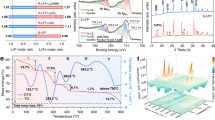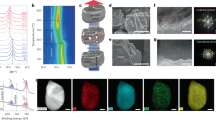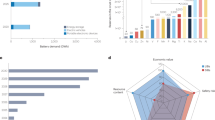Abstract
The accelerating adoption of electric vehicles supports the transition to a more sustainable transport sector. However, the retiring of many electric vehicles over the next decade poses a sustainability challenge, particularly due to the lack of recycling of end-of-life batteries. Here we show regeneration routes that could valorize spent cathodes for a second life in both lithium-ion batteries (LIBs) and post-LIBs. Our regeneration starts with a leaching process involving acetic acid that could selectively dissolve high-value elements in cathodes including lithium, cobalt, nickel and manganese. Depending on the added chelating agents, further co-precipitation reactions in the leachate form precursors of different cathode materials. The regenerated lithium layered oxide cathodes deliver a reversible area capacity of up to 2.73 mAh cm−2 with excellent structural stability for LIBs, whereas the obtained Prussian blue analogues show 83.7% retention after 2,000 cycles for sodium-ion batteries (SIBs). Life-cycle and techno-economic assessments suggest that the current regeneration can reduce manufacturing costs for LIBs and SIBs by US$21.65 kWh−1 and US$41.67 kWh−1, respectively, with lower impacts on human health, environment and natural resources. This work paves the way for the transition to more sustainable storage technologies.
This is a preview of subscription content, access via your institution
Access options
Access Nature and 54 other Nature Portfolio journals
Get Nature+, our best-value online-access subscription
$29.99 / 30 days
cancel any time
Subscribe to this journal
Receive 12 digital issues and online access to articles
$119.00 per year
only $9.92 per issue
Buy this article
- Purchase on Springer Link
- Instant access to full article PDF
Prices may be subject to local taxes which are calculated during checkout




Similar content being viewed by others
Data availability
The data supporting the research in this paper are available within the article and its Supplementary Information or from the corresponding authors upon reasonable request. Source data are provided with this paper.
References
Chu, S. & Majumdar, A. Opportunities and challenges for a sustainable energy future. Nature 488, 294–303 (2012).
Tollefson, J. Car industry: charging up the future. Nature 456, 436–440 (2008).
Larcher, D. & Tarascon, J.-M. Towards greener and more sustainable batteries for electrical energy storage. Nat. Chem. 7, 19–29 (2015).
Bauer, C. et al. Charging sustainable batteries. Nat. Sustain. 5, 176–178 (2022).
Harper, G. et al. Recycling lithium-ion batteries from electric vehicles. Nature 575, 75–86 (2019).
Fan, E. et al. Sustainable recycling technology for Li-ion batteries and beyond: challenges and future prospects. Chem. Rev. 120, 7020–7063 (2020).
Yang, T., Luo, D., Yu, A. & Chen, Z. Enabling future closed-loop recycling of spent lithium-ion batteries: direct cathode regeneration. Adv. Mater. https://doi.org/10.1002/adma.202203218 (2023).
Chen, M. et al. Recycling end-of-life electric vehicle lithium-ion batteries. Joule 3, 2622–2646 (2019).
Sommerville, R. et al. A qualitative assessment of lithium ion battery recycling processes. Resour. Conserv. Recycl. 165, 105219 (2021).
Ding, Y., Cano, Z. P., Yu, A., Lu, J. & Chen, Z. Automotive Li-ion batteries: current status and future perspectives. Electrochem. Energy Rev. 2, 1–28 (2019).
Mohamed, N. & Allam, N. K. Recent advances in the design of cathode materials for Li-ion batteries. RSC Adv. 10, 21662–21685 (2020).
Gupta, V. et al. Scalable direct recycling of cathode black mass from spent lithium‐ion batteries. Adv. Energy Mater. 13, 2203093 (2023).
Ciez, R. E. & Whitacre, J. F. Examining different recycling processes for lithium-ion batteries. Nat. Sustain. 2, 148–156 (2019).
Ma, X. et al. Recycled cathode materials enabled superior performance for lithium-ion batteries. Joule 5, 2955–2970 (2021).
Wang, T. et al. Direct recycling of spent NCM cathodes through ionothermal lithiation. Adv. Energy Mater. 10, 2001204 (2020).
Zhang, X. et al. Innovative application of acid leaching to regenerate Li(Ni1/3Co1/3Mn1/3)O2 cathodes from spent lithium-ion batteries. ACS Sustain. Chem. Eng. 6, 5959–5968 (2018).
Li, L. et al. Recovery of metals from spent lithium-ion batteries with organic acids as leaching reagents and environmental assessment. J. Power Sources 233, 180–189 (2013).
Song, J. H., Kwon, O.-H., Oh, H.-M., Kang, E.-Y. & Oh, S. M. The electrochemical properties of spherial-LiNi0.5−xMn0.5CoxO2 cathode material for lithium rechargeable batteries. In Proc PBFC-2 2nd International Conference on Polymer Batteries and Fuel Cells (ed. The Electrochemical Society). ECS Meet. Abstr. MA2005-03 22 (2005).
Cheralathan, K. K. et al. Preparation of spherical LiNi0.80Co0.15Mn0.05O2 lithium-ion cathode material by continuous co-precipitation. J. Power Sources 195, 1486–1494 (2010).
Hou, P. Y., Zhang, H. Z., Zi, Z. Y., Zhang, L. Q. & Xu, X. J. Core–shell and concentration-gradient cathodes prepared via co-precipitation reaction for advanced lithium-ion batteries. J. Mater. Chem. A 5, 4254–4279 (2017).
Wang, Z. et al. Catalytically induced robust inorganic‐rich cathode electrolyte interphase for 4.5 V Li||NCM622 batteries. Adv. Funct. Mater. 33, 2212150 (2023).
Chen, Z. et al. Hierarchical porous LiNi1/3Co1/3Mn1/3O2 nano-/micro spherical cathode material: minimized cation mixing and improved Li+ mobility for enhanced electrochemical performance. Sci. Rep. 6, 25771 (2016).
Lu, Y. et al. Dry electrode technology, the rising star in solid-state battery industrialization. Matter 5, 876–898 (2022).
Li, J. et al. Facilitating the operation of lithium-ion cells with high-nickel layered oxide cathodes with a small dose of aluminum. Chem. Mater. 30, 3101–3109 (2018).
Li, J. & Manthiram, A. A comprehensive analysis of the interphasial and structural evolution over long‐term cycling of ultrahigh‐nickel cathodes in lithium‐ion batteries. Adv. Energy Mater. 9, 1902731 (2019).
Li, W. et al. Dynamic behaviour of interphases and its implication on high-energy-density cathode materials in lithium-ion batteries. Nat. Commun. 8, 14589 (2017).
Duffner, F. et al. Post-lithium-ion battery cell production and its compatibility with lithium-ion cell production infrastructure. Nat. Energy 6, 123–134 (2021).
Yi, H. et al. Structure and properties of Prussian blue analogues in energy storage and conversion applications. Adv. Funct. Mater. 31, 2006970 (2021).
Zeng, Y. et al. Construction of Co–Mn Prussian blue analog hollow spheres for efficient aqueous Zn-ion batteries. Angew. Chem. Int. Ed. 60, 22189–22194 (2021).
Zeng, Y. et al. Formation of CuMn Prussian blue analog double-shelled nanoboxes toward long-life Zn-ion batteries. Angew. Chem. Int. Ed. 61, e202212031 (2022).
Xuan, C. et al. Heteroatom (P, B, or S) incorporated NiFe-based nanocubes as efficient electrocatalysts for the oxygen evolution reaction. J. Mater. Chem. A 6, 7062–7069 (2018).
Ma, Y. et al. High-entropy metal–organic frameworks for highly reversible sodium storage. Adv. Mater. 33, e2101342 (2021).
Muñoz‐Márquez, M. Á., Zarrabeitia, M., Passerini, S. & Rojo, T. Structure, composition, transport properties, and electrochemical performance of the electrode–electrolyte interphase in non‐aqueous Na‐ion batteries. Adv. Mater. Interface 9, 2101773 (2022).
Moeez, I., Susanto, D., Chang, W., Lim, H.-D. & Chung, K. Y. Artificial cathode electrolyte interphase by functional additives toward long-life sodium-ion batteries. Chem. Eng. J. 425, 130547 (2021).
Zhao, S. P. & You, F. Q. Comparative life-cycle assessment of Li-ion batteries through process-based and integrated hybrid approaches. ACS Sustain. Chem. Eng. 7, 5082–5094 (2019).
Thompson, D. et al. To shred or not to shred: a comparative techno-economic assessment of lithium ion battery hydrometallurgical recycling retaining value and improving circularity in LIB supply chains. Resour. Conserv. Recycl. 175, 105741 (2021).
Acknowledgements
Z.C. acknowledges the support from the Power Battery and Systems Research Center from State Key Laboratory of Catalysis, Strategic Priority Research Program of Chinese Academy of Sciences (XDB0600104), Dalian Revitalization Talents Program (2022RG01), Liaoning Binhai Laboratory (LBLB202304), Vacuum Interconnected Nanotech Workstation (Nano-X, Suzhou Institute of Nano-Tech and Nano-Bionics), the Natural Sciences and Engineering Research Council of Canada (NSERC), the University of Waterloo and the Waterloo Institute for Nanotechnology. Allocation of beamtime at HXMA, SXRMB and VESPERS, CLS, Saskatoon, Canada, is gratefully acknowledged. We also thank Shiyanjia Lab (www.shiyanjia.com) for the LCA.
Author information
Authors and Affiliations
Contributions
T.Y., Y.Z. and Z.C. designed the research. T.Y. and Z.C. completed most of the experiments and drafted the paper. D.L., Q.M. and R.G. assisted in the design of some advanced characterization methods and provided extensive suggestions for the paper. Z.C., X.Z., S.G. and T.O. supervized the project and assembled the pouch cells. Z.C., D.L. and H.W.P. made significant contributions to the analysis and editing of the paper. All authors discussed and contributed to the results.
Corresponding authors
Ethics declarations
Competing interests
The authors declare no competing interests.
Peer review
Peer review information
Nature Sustainability thanks the anonymous reviewers for their contribution to the peer review of this work.
Additional information
Publisher’s note Springer Nature remains neutral with regard to jurisdictional claims in published maps and institutional affiliations.
Supplementary information
Supplementary Information
Supplementary Figs. 1–54 and Tables 1–46.
Source data
Source Data Fig. 1
ICP results.
Source Data Fig. 2
Electrochemical performance of LIBs.
Source Data Fig. 3
Electrochemical performance of SIBs.
Source Data Fig. 4
Techno-economic analysis and LCA results.
Rights and permissions
Springer Nature or its licensor (e.g. a society or other partner) holds exclusive rights to this article under a publishing agreement with the author(s) or other rightsholder(s); author self-archiving of the accepted manuscript version of this article is solely governed by the terms of such publishing agreement and applicable law.
About this article
Cite this article
Yang, T., Luo, D., Zhang, X. et al. Sustainable regeneration of spent cathodes for lithium-ion and post-lithium-ion batteries. Nat Sustain (2024). https://doi.org/10.1038/s41893-024-01351-5
Received:
Accepted:
Published:
DOI: https://doi.org/10.1038/s41893-024-01351-5



